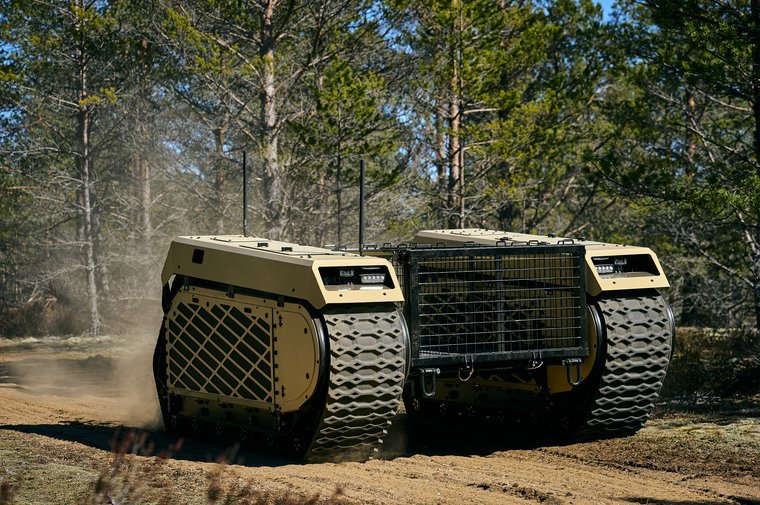Revolutionising Warfare: The Rapid Rise and Future of UGVs (Analysis)
Details
More Products & Services
Products & Services
Defence Insight
Shephard Media
Some of the things people like you use Defence Insight for:
- Total addressable market sizing ($)
- Competitor analysis
- Cost analysis
- Market forecasting
- Growth identification
- Increasing closing ratio
- Increasing closing order value
- Estimating product potential
- Calculating sales forecasting
- Supply and demand analysis
- Total addressable market sizing ($)
- Competitor analysis
- Cost analysis
- Market forecasting
- Growth identification
- Increasing closing ratio
- Increasing closing order value
- Estimating product potential
- Calculating sales forecasting
- Supply and demand analysis
Shephard Plus Update
Shephard Media
Shephard Plus is updating in June 2018 with rich new capabilities, and is now one of the most cost-effective and valuable aerospace and defence market intell...
Military Unmanned Systems Handbook
Shephard Media
The Military Unmanned Systems Handbook (Digital Download) is an international guide to the military UV industry and provides detailed information on air, ground and sea (surface & sub-sea) vehicles as well as subsystems. What's included: Unencrypted 390+ page PDF of equipment and supplier information Market summary
Description
The uncrewed ground vehicle (UGV) market is evolving rapidly, driven by technological advancements, geopolitical shifts, and changing defence priorities.
The UGV market is experiencing significant technological growth, particularly in areas such as autonomy, remote control, and electrification. These advancements are transforming UGVs from simple resupply vehicles to sophisticated systems capable of various military applications.
In our recent webinar, ‘The Future of European Defence: Insights and Strategies Ahead of Eurosatory 2024', the rapid pace of UGV innovation was one of the core themes of our conversation.
The conflict in Ukraine has had a profound effect on the defence industry. It has highlighted the importance of rapid deployment and resupply capabilities, leading to increased interest in UGVs for logistics and reconnaissance roles.
The Ukraine conflict has driven a resurgence in demand for existing platforms and underscored the need for advanced UGVs to enhance operational efficiency and reduce risks to personnel.
Despite advancements, the UGV market faces hurdles like the limited adoption of weaponised UGVs due to political and ethical concerns about “killer robots.” Additionally, the defence industry's production capacity is under strain.
Decades of consolidation and outsourcing have reduced the surge capacity of many manufacturers, making it difficult to scale up production rapidly. The supply chain is also under serious pressure, with lead times for ramping up production measured in years, not months.
Nevertheless, the UGV market is poised for significant growth. Increased investment in research and development, particularly in artificial intelligence and autonomous systems, will enhance UGV capabilities. Key Trends, Current Programmes
An analysis by Defence Insight and Cytec Consulting revealed the key trends, current programmes, regional dynamics, and future innovations shaping the development and deployment of UGVs within NATO countries.
Based on trends in concept development and experimentation for UGVs across NATO, the current focus on UGV development appears to be on the so-called ‘last mile resupply' solution.
In all but one of the European programmes examined, current trials and development of UGV platforms were limited to Mule, CASEVAC, and ISR uses, with platforms such as the Rheinmetall Mission Master and GDLS MUTT leading in this field. Working under 5-year ‘Epochs,' the British Army, for example, is reportedly focused on unarmed UGVs for at least the first ten years of its development.Hybrid Engines and Auxiliary Power Units
Another common feature highlighted in the US Army's S-MET programme and prevalent among the top UGVs in NATO nations is the widespread use of diesel-electric hybrid power systems.
An electric engine adds additional range/endurance while improving ease of maintenance and enabling silent running. Another key finding is the stressed importance of Auxiliary Power Units, allowing squads and platoons to draw power from their UGVs to recharge small electronic devices such as the ‘Dismounted Situational Awareness' system currently undergoing trials with several NATO countries.Tracks vs Wheels
Mirroring the wider armoured vehicles market, UGVs follow a similar divide between tracks and wheels. Outside the THeMIS from Milrem, NATO-adopted UGVs appear almost entirely wheeled, with an emphasis on 8x8 platforms. US Marines test a Tethered Unmanned Ariel Vehicle (MUTT-T-UAV) during Advanced Naval Technology Exercise 2018 (ANTX18). (Photo: US Marine Corps)
This emphasis on wheels, however, is likely a result of the UGVs' intended use, which is in line with current market propensities. For mule and CASEVAC roles especially, wheels are understandably the preferred choice due to their weight, speed, and cost burden compared to tracks.Remote Weapon Systems (RWS) - Too Soon?
The fourth and potentially most interesting finding is the apparent reluctance of NATO countries to develop publicly and trial RWS-mounted UGVs.
Of NATO countries, only the Netherlands has begun significant trials with the Milrem THeMIS, which is armed with a .50 cal machine gun mounted onto an R400S Mk2 RWS. Outside of the Netherlands, all other countries within the scope of analysis appear to be focusing on unarmed UGVs until at least the 2030s.
This may be due to the same political pressures initially affecting MALE and HALE UAVs in the early 2010s regarding the moral component of autonomous offensive action.
The UGV market is at a pivotal point in its development, with technological advancements and geopolitical changes driving increased interest and investment. Overcoming political, ethical, and production challenges will be crucial to realising the full potential of UGVs. For a more detailed examination of the UGV market and the opportunities for European manufacturers, see Defence Insight and Cytec's 3500-word market report.
Shephard's Eurosatory 2024 coverage is sponsored by:
The UGV market is experiencing significant technological growth, particularly in areas such as autonomy, remote control, and electrification. These advancements are transforming UGVs from simple resupply vehicles to sophisticated systems capable of various military applications.
In our recent webinar, ‘The Future of European Defence: Insights and Strategies Ahead of Eurosatory 2024', the rapid pace of UGV innovation was one of the core themes of our conversation.
The conflict in Ukraine has had a profound effect on the defence industry. It has highlighted the importance of rapid deployment and resupply capabilities, leading to increased interest in UGVs for logistics and reconnaissance roles.
The Ukraine conflict has driven a resurgence in demand for existing platforms and underscored the need for advanced UGVs to enhance operational efficiency and reduce risks to personnel.
Despite advancements, the UGV market faces hurdles like the limited adoption of weaponised UGVs due to political and ethical concerns about “killer robots.” Additionally, the defence industry's production capacity is under strain.
Decades of consolidation and outsourcing have reduced the surge capacity of many manufacturers, making it difficult to scale up production rapidly. The supply chain is also under serious pressure, with lead times for ramping up production measured in years, not months.
Nevertheless, the UGV market is poised for significant growth. Increased investment in research and development, particularly in artificial intelligence and autonomous systems, will enhance UGV capabilities. Key Trends, Current Programmes
An analysis by Defence Insight and Cytec Consulting revealed the key trends, current programmes, regional dynamics, and future innovations shaping the development and deployment of UGVs within NATO countries.
Based on trends in concept development and experimentation for UGVs across NATO, the current focus on UGV development appears to be on the so-called ‘last mile resupply' solution.
In all but one of the European programmes examined, current trials and development of UGV platforms were limited to Mule, CASEVAC, and ISR uses, with platforms such as the Rheinmetall Mission Master and GDLS MUTT leading in this field. Working under 5-year ‘Epochs,' the British Army, for example, is reportedly focused on unarmed UGVs for at least the first ten years of its development.Hybrid Engines and Auxiliary Power Units
Another common feature highlighted in the US Army's S-MET programme and prevalent among the top UGVs in NATO nations is the widespread use of diesel-electric hybrid power systems.
An electric engine adds additional range/endurance while improving ease of maintenance and enabling silent running. Another key finding is the stressed importance of Auxiliary Power Units, allowing squads and platoons to draw power from their UGVs to recharge small electronic devices such as the ‘Dismounted Situational Awareness' system currently undergoing trials with several NATO countries.Tracks vs Wheels
Mirroring the wider armoured vehicles market, UGVs follow a similar divide between tracks and wheels. Outside the THeMIS from Milrem, NATO-adopted UGVs appear almost entirely wheeled, with an emphasis on 8x8 platforms. US Marines test a Tethered Unmanned Ariel Vehicle (MUTT-T-UAV) during Advanced Naval Technology Exercise 2018 (ANTX18). (Photo: US Marine Corps)
This emphasis on wheels, however, is likely a result of the UGVs' intended use, which is in line with current market propensities. For mule and CASEVAC roles especially, wheels are understandably the preferred choice due to their weight, speed, and cost burden compared to tracks.Remote Weapon Systems (RWS) - Too Soon?
The fourth and potentially most interesting finding is the apparent reluctance of NATO countries to develop publicly and trial RWS-mounted UGVs.
Of NATO countries, only the Netherlands has begun significant trials with the Milrem THeMIS, which is armed with a .50 cal machine gun mounted onto an R400S Mk2 RWS. Outside of the Netherlands, all other countries within the scope of analysis appear to be focusing on unarmed UGVs until at least the 2030s.
This may be due to the same political pressures initially affecting MALE and HALE UAVs in the early 2010s regarding the moral component of autonomous offensive action.
The UGV market is at a pivotal point in its development, with technological advancements and geopolitical changes driving increased interest and investment. Overcoming political, ethical, and production challenges will be crucial to realising the full potential of UGVs. For a more detailed examination of the UGV market and the opportunities for European manufacturers, see Defence Insight and Cytec's 3500-word market report.
Shephard's Eurosatory 2024 coverage is sponsored by:

Share
Recent Chats
Share via email
Future: handle WhatsApp here
Future: handle LinkedIn here
Future: handle Twitter here
SUBMENU HERE
Share via Chat
Copy Link



